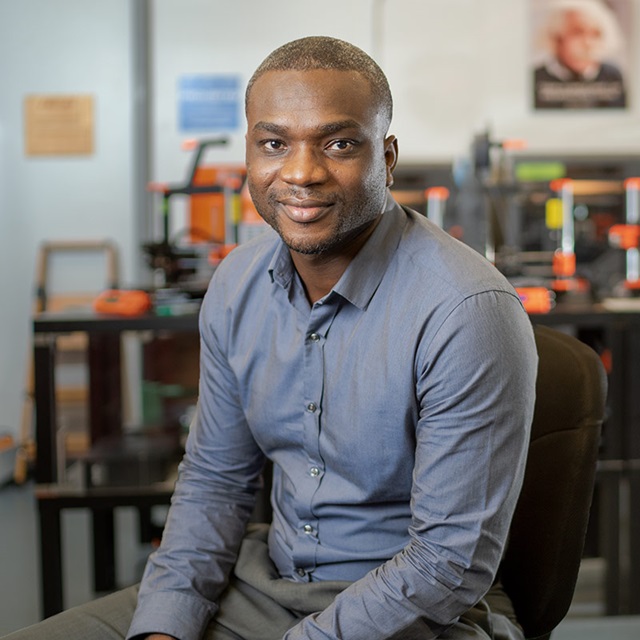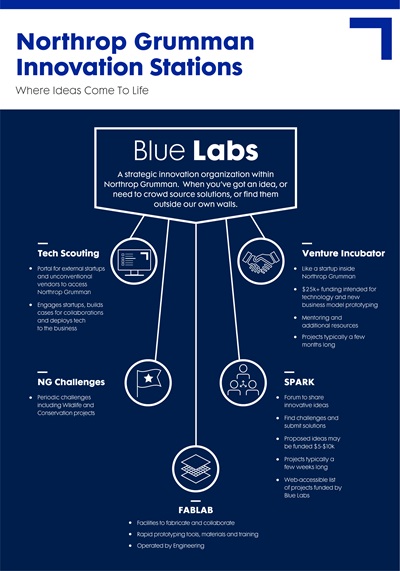The Northrop Grumman program that turns personal passions into professional development
After a fire nearly destroyed the Notre Dame Cathedral in Paris in 2019, Yaakov was surprised to hear on the news that the most accurate digital rendering ever created of the ancient Parisian church was for a video game he had played: Assassin’s Creed: Unity. The game’s developers created the rendering using lidar (light detection and ranging). Lidar is a technique similar to radar, but instead of measuring distance by bouncing radio waves off objects, it targets an object with a laser and measures the time for the light to return. Usually the laser sits on a tripod.
After learning about Assassin’s Creed: Unity’s use of lidar for its rendition of Notre Dame, Yaakov had a Eureka moment. He asked himself, what if they mounted lidar on small drones to more quickly and accurately image a space?
Hoping to develop his idea further, Yaakov took it to SPARK.
SPARK is a Northrop Grumman business development program under the Blue Labs organization that allows employees to explore technical ideas not always covered by contracted programs. Employees can present an idea and potentially earn funding to support its exploration. Sometimes, SPARK ideas make their way to another program called Venture Incubator, where participants are also offered networking opportunities, legal advice and tips on building a business plan.
The entire experience helps employees grow their skills and brings exciting new technologies to the company. Many of those who participate in Blue Labs’ various innovation programs are working on a project with personal resonance to them, a passion outside of work or a technical topic that interests them and isn’t necessarily part of their day job.
Yaakov, a space vehicle engineer in Redondo Beach, California, spoke with active-duty military service members and learned that accurate, timely intelligence was one of their most vital tools. He developed his idea of 3D mapping through lidar-mounted drones into a concept that Northrop Grumman’s customers could use to obtain the best intelligence possible. He calls his program Pathfinder.
“As an industry, we’re all just figuring out the potential of AR (augmented reality) together. It’s like the early internet, where we are all pushing the boundaries and discovering the possibilities with it.”
Sarah, Augmented Reality Lead
While Yaakov’s personal experiences with video games lead to the creation of Pathfinder, Sarah leaned on her professional past to create an innovative program using SPARK. Sarah was on an Emmy Award-winning team for her work in augmented reality (AR) design and innovation and has worked in a number of industries in that space. When she came to Northrop Grumman last year as a product owner/AR lead in Roy, Utah, she saw many opportunities for the company to use AR.
Working with her colleague John , Sarah came up with the idea for HIDDEN (Holographic Interface for Drone Deployment Engagement, and Navigation), an interactive system for drone deployment and navigation that uses a hologram interface. It allows one person to deploy and coordinate multiple unmanned vehicles. When it’s complete, the user will be presented with a three-dimensional representation of where the drones are in relation to each other, with respect to local terrain, and can interact with the holographic representation by using natural gestures to zoom in or out, select drones individually or as a group, inspect drone status and execute commands.

“We’re looking at the HIDDEN system as a force multiplier,” she said. “This specific project excites me in that way, were we are doing something that has never been done before in this application and it could advance current methods used in military operations.”
Sarah brought the idea to SPARK and secured funding that helped her and a small team build a prototype. She said the HIDDEN prototype has attracted interest from corners of the company she never anticipated. Similarly to Yaakov, Sarah’s idea was granted into the Venture Incubator program, which provided additional resources and opportunities that aren’t available solely through SPARK.
“As an industry, we’re all just figuring out the potential of AR together. It’s like the early internet, where we are all pushing the boundaries and discovering the possibilities with it,” she said. “It shows how amazing the SPARK opportunity is and the reach that it gives. It has opened a lot of doors to the next level of technology.”
Technology is a personal passion for Herlans, a manager of electronic engineering in Melbourne, Florida. He enjoys applying existing concepts to new fields, and wondered if the technology behind medical devices that transmit data could be applied to airplane antennae.
“Antannae are extremely bulky, have a lot of wiring and can be very heavy,” Herlans said. “We’re trying to reduce the amount of hard labor; reduce the amount of wiring. We’re trying to speed up the process of radio frequency system.”
Herlans’ idea is to create an antenna similar to the kinds of wearable medical transmitters that stick to a patient’s skin, like glucose monitors for people with diabetes. Herlans and his team have studied available research and materials and believe they can create an antennae that sticks flat to a wing, saving space and weight on board the aircraft. He credited SPARK with helping him investigate something so novel to the aeronautics industry.
“As a company, if you want to have longevity, you can’t just think about now,” Herlans said. “You have to think about the future.”
Like Herlans, Yaakov said he hopes to continue into the future with his Pathfinder project, and is even mulling over other ideas he’d like to pitch to SPARK and the Venture Incubator. The program is a part of Northrop Grumman that operates more like a tech startup and he said he finds that very exciting.
“This is where there is no red tape, you have the ability to take the wacky idea that you have and see where it takes you,” he said. “I would not have been able to take this as far as I have without SPARK backing me.”
Return to the Life at Northrop Grumman home page.
